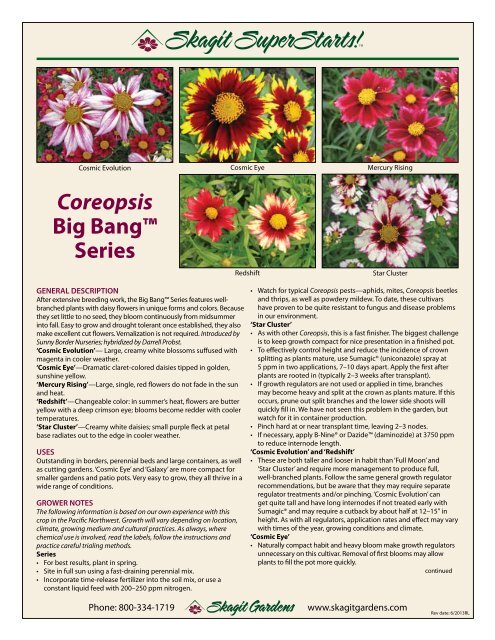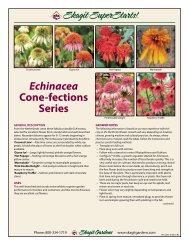Coreopsis Big Bang Series
Grower's Notes - Skagit Gardens
Grower's Notes - Skagit Gardens
- No tags were found...
Create successful ePaper yourself
Turn your PDF publications into a flip-book with our unique Google optimized e-Paper software.
Cosmic Evolution<strong>Coreopsis</strong><strong>Big</strong> <strong>Bang</strong><strong>Series</strong>Cosmic EyeRedshiftMercury RisingStar ClusterGENERAL DESCRIPTIONAfter extensive breeding work, the <strong>Big</strong> <strong>Bang</strong> <strong>Series</strong> features wellbranchedplants with daisy flowers in unique forms and colors. Becausethey set little to no seed, they bloom continuously from midsummerinto fall. Easy to grow and drought tolerant once established, they alsomake excellent cut flowers. Vernalization is not required. Introduced bySunny Border Nurseries; hybridized by Darrell Probst.‘Cosmic Evolution’— Large, creamy white blossoms suffused withmagenta in cooler weather.‘Cosmic Eye’—Dramatic claret-colored daisies tipped in golden,sunshine yellow.‘Mercury Rising’—Large, single, red flowers do not fade in the sunand heat.‘Redshift’—Changeable color: in summer’s heat, flowers are butteryellow with a deep crimson eye; blooms become redder with coolertemperatures.‘Star Cluster’—Creamy white daisies; small purple fleck at petalbase radiates out to the edge in cooler weather.USESOutstanding in borders, perennial beds and large containers, as wellas cutting gardens. ‘Cosmic Eye’ and ‘Galaxy’ are more compact forsmaller gardens and patio pots. Very easy to grow, they all thrive in awide range of conditions.GROWER NOTESThe following information is based on our own experience with thiscrop in the Pacific Northwest. Growth will vary depending on location,climate, growing medium and cultural practices. As always, wherechemical use is involved, read the labels, follow the instructions andpractice careful trialing methods.<strong>Series</strong>• For best results, plant in spring.• Site in full sun using a fast-draining perennial mix.• Incorporate time-release fertilizer into the soil mix, or use aconstant liquid feed with 200–250 ppm nitrogen.• Watch for typical <strong>Coreopsis</strong> pests—aphids, mites, <strong>Coreopsis</strong> beetlesand thrips, as well as powdery mildew. To date, these cultivarshave proven to be quite resistant to fungus and disease problemsin our environment.‘Star Cluster’• As with other <strong>Coreopsis</strong>, this is a fast finisher. The biggest challengeis to keep growth compact for nice presentation in a finished pot.• To effectively control height and reduce the incidence of crownsplitting as plants mature, use Sumagic® (uniconazole) spray at5 ppm in two applications, 7–10 days apart. Apply the first afterplants are rooted in (typically 2–3 weeks after transplant).• If growth regulators are not used or applied in time, branchesmay become heavy and split at the crown as plants mature. If thisoccurs, prune out split branches and the lower side shoots willquickly fill in. We have not seen this problem in the garden, butwatch for it in container production.• Pinch hard at or near transplant time, leaving 2–3 nodes.• If necessary, apply B-Nine® or Dazide (daminozide) at 3750 ppmto reduce internode length.‘Cosmic Evolution’ and ‘Redshift’• These are both taller and looser in habit than ‘Full Moon’ and‘Star Cluster’ and require more management to produce full,well-branched plants. Follow the same general growth regulatorrecommendations, but be aware that they may require separateregulator treatments and/or pinching. ‘Cosmic Evolution’ canget quite tall and have long internodes if not treated early withSumagic® and may require a cutback by about half at 12–15" inheight. As with all regulators, application rates and effect may varywith times of the year, growing conditions and climate.‘Cosmic Eye’• Naturally compact habit and heavy bloom make growth regulatorsunnecessary on this cultivar. Removal of first blooms may allowplants to fill the pot more quickly.continuedPhone: 800-334-1719www.skagitgardens.comRev date: 6/2013RL
GROWER NOTES continued‘Mercury Rising’• With a habit between ‘Cosmic Eye’ and ‘Star Cluster’, this varietyis more mounding than the taller ones, but not quite compact.A pinch or a growth regulator application (B-Nine® or Sumagic®)early in production may be helpful in producing full plants, but isnot always necessary.PLANT DATAUSDA Zone: 5(-20º)Bloom time: summer–fall‘Cosmic Evolution’Height: 24–30"/30"Spread: 24"‘Cosmic Eye’Height: 12–15"/15"Spread: 12"APPROXIMATE FINISH TIMES‘Cosmic Evolution’, ‘Mercury Rising’, ‘Redshift’ and ‘Star Cluster’• Gallon from 128-cell liner: 7–9 weeks• Gallon from 72-cell liner: 5–6 weeks• 2-gallon from 72-cell liners: 12–14 weeks‘Cosmic Eye’• Gallon from 128-cell liner: 10–12 weeks• Gallon from 72-cell liner: 7–9 weeks• 2-gallon from 72-cell liner: 12–14 weeksPATENT INFORMATIONAsexual propagation prohibited• C. ‘Cosmic Evolution’: USPP #22943• C. ‘Cosmic Eye’: USPP #22601• C. ‘Mercury Rising’: USPPP• C. ‘Redshift’: USPP #20412• C. ‘Star Cluster’: USPP #23035‘Mercury Rising’Height: 15–18"/18"Spread: 24"‘Redshift’Height: 24–30"/30"Spread: 18"‘Star Cluster’Height: 18–24"/24"Spread: 24"Cosmic EyeMercury RisingStar ClusterPhone: 800-334-1719www.skagitgardens.com





